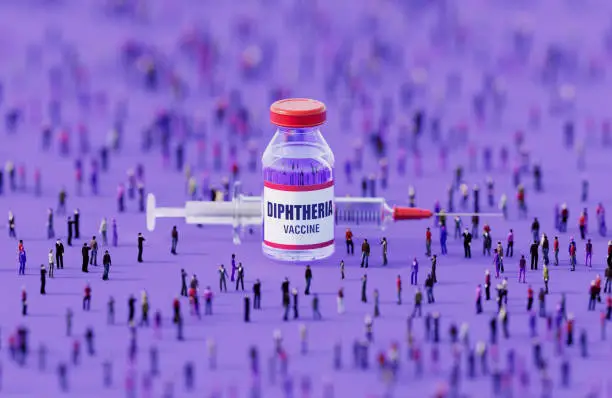How to treat diphtheria: A Guide to the Disease and Its Effects
Diphtheria is a potentially fatal bacterial infection mostly affecting the respiratory system but can also involve the skin and other organs. Corynebacterium diphtheriae: this disease used to cause more death in children worldwide than all of the other diseases combined.
Nevertheless, due to the wide availability and uptake of immunization schedules such as the DTaP (diphtheria, tetanus, and pertussis) vaccine, the incidence of diphtheria has substantially decreased. Nevertheless, it is important to have a plan and be aware of this disease in low-vaccinated areas.
What is Diphtheria?
Diphtheria is an infection caused by a bacterium, Corynebacterium diphtheriae, that makes an extremely powerful toxin that damages tissue. Infection usually begins in the nose and throat, where the bacteria adhere to mucous membranes.

Once these areas are colonized, Corynebacterium diphtheriae releases a toxin that can cause up to wracking inflammation, tissue death, and a characteristic greyish membrane to form in the throat that can close air passages and affect breathing. In rarer instances, the toxin can travel in the bloodstream and reach other organs—including the heart and kidneys—causing even more serious complications.
It spreads via droplets expelled by coughing or sneezing by someone infected with the disease. Its also transmitted by direct contact with contaminated surfaces or objects, which makes it highly contagious.
Symptoms of Diphtheria
In general, the symptoms of diphtheria appear 2 to 5 days after exposure to the bacteria, but the time frame may vary. Initial signs are often similar to any number of upper respiratory infections—I mean, the common cold—but they deteriorate and evolve into more severe symptoms:
A sore throat: It was one of the first signs, usually accompanied by difficulty swallowing and a husky voice.
Fever and chills: The infection causes an infection response, which takes the form of a fever and chills.
Fatigue and weakness: As your body battles the infection, you may feel very tired and weak.
Enlarged lymph nodes: The lymph nodes in the neck may become tender / swollen.
Characteristic membrane: One of the hallmarks of diphtheria is a greyish-white membrane that can form in the throat, obstructing the airway and making it harder to breathe. This membrane can also bleed if jarred.
Struggling or suffocating: If the airway is obstructed, there is labored breathing, wheezing, strider, and/or suffocating.
Skin infections: Diphtheria can sometimes affect the skin, causing ulcers or sores that develop a grey membrane over the top.
Disease severity can range from mild to severe. In milder cases, this can be reduced to a sore throat and mild fever. However, in more severe cases—particularly when the toxin spreads to other parts of the body—it can cause complications including myocarditis (inflammation of the heart muscle), kidney failure, and nerve damage.
Diphtheria Complications
Although diphtheria is easily treated with antibiotics, if left untreated, it can lead to serious, even fatal complications. The diphtheria toxin is capable of wreaking havoc throughout the body and affects, in particular:
The heart: The toxin can cause myocarditis, an inflammation of the heart muscle. This can hinder the heart’s capacity to pump blood, resulting in arrhythmias (irregular heartbeats), heart failure, or even sudden death.
Nerves: The diphtheria toxin can also damage peripheral nerves, leading to nerve damage. It can cause symptoms that include weakness, paralysis and problems with swallowing and speech.
Kidneys: In a serious diphtheria case, it can lead to kidney failure, especially if the infection is allowed to go untreated for a long time.
Obstruction in the airway: The typical membrane found in the throat can cover the airway and cause suffocation if not treated on time. In severe cases, intubation and mechanical ventilation may be necessary.
Diagnosis of Diphtheria
Diagnosis is mainly based on symptoms, particularly the presence of a grey membranous area in the throat. Laboratory testing, however, is required to confirm the presence of Corynebacterium diphtheriae and differentiate this pathogen from other similar infections. The common diagnostic tests are as follows:
Throat culture: A sample is taken from the throat and cultured in a lab to identify the bacteria. “This is the most definitive way to diagnose diphtheria.
Polymerase chain reaction (PCR): A molecular test can identify the genetic material of *Corynebacterium diphtheriae in throat swabs, making for a more rapid diagnosis.
Electrocardiogram (ECG): If heart complications are suspected, an ECG may be obtained to identify abnormal heart functions.
Treatment for Diphtheria
Diphtheria can be serious, but prompt treatment is critical in reducing severity and preventing complications. The main parts of treatment are:
Antibiotics: Treatment of diphtheria includes antibiotics—often penicillin or erythromycin—to kill the bacteria. Antibiotics curtail the spread of infection but do not neutralize any toxin already present in the body.
Diphtheria antitoxin: A diphtheria antitoxin is essential because the diphtheria toxin can cause serious damage. This serum, which comes from immunized horses, neutralizes the toxin and can prevent further damage. Antitoxin is most effective when given early.
Supportive care: For patients with acute respiratory distress, hospitalization, respiratory support, and monitoring for complications such as heart or kidney failure may be necessary. In extreme cases, airways may be obstructed, and mechanical ventilation may be required.
Surgical intervention—If the membrane in the throat blocks the airway, it may need to be surgically removed to allow for breathing.
Prevention of Diphtheria
Vaccination is the single most effective means of prevention of diphtheria. The diphtheria vaccine, typically given in combination with those for tetanus and pertussis (DTaP), is highly effective at preventing the disease. By training the immune system to produce antibodies directed against the diphtheria toxin, the vaccine provides immunity but does not cause the disease itself.
Immunization schedules usually include the following:
Vaccine during childhood: The DTaP vaccine is a basic childhood vaccine and is givens during a series of doses at 2 months, with boosters at 4, 6, and 15-18 months. At 4–6 years of age, a final booster is administered.
Adolescent and adult boosters: Adolescents and adults should receive a Td (tetanus and diphtheria) or Tdap (tetanus, diphtheria, and pertussis) vaccine booster every 10 years. That means they will still get protection against diphtheria, which is important since antibody dwindles after a time.
Herd immunity: When large numbers of people are vaccinated, the entire community is better protected, including those who cannot be vaccinated for medical reasons, such as infants too young to receive the vaccine or people with weakened immune systems.
Conclusion
Even with the advent of vaccines, diphtheria is still a serious, potentially life-threatening infection, especially among unvaccinated populations. Although the disease has been brought under relative control throughout much of the world through effective vaccination programs, it continues to pose a potentially explosive reality.
Early recognition, diagnosis, and treatment are vital in managing diphtheria and preventing complications. Vaccination is the cornerstone of diphtheria prevention, helping to protect both individuals and communities against this deadly infection. With vaccination ongoing on a global scale, it is hoped that the incidence of this once ubiquitous infection will eventually be reduced to zero.




Leave a Reply